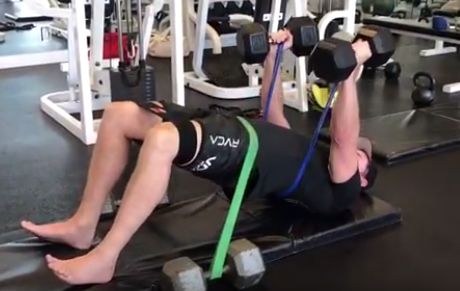Everyone wants bigger and stronger glutes, and most people love to train variations of the bench press. Sometimes you don’t have time to train both. Other times you just want a novel way to develop them. That’s where the bridge press comes in.
Bridge Press
I came with this exercise years ago for the combat athletes I was working with. The purpose was to build their punching power while maximally engaging their hip extensors, a group of muscles largely responsible for explosive strikes. Indeed, you need super strong glutes and hamstrings to develop devastating punches and kicks.
The other benefit of this exercise is that it allows you to train two foundational movements patterns with one exercise. Pair the bridge press with an upper-body pull, such as a pull-up or row, and you’ve got an efficient full-body workout that builds functional strength.
I use multiple variations of the bridge press for my clients, but today I want to cover the three primary versions that work especially well for virtually anyone. We’ll start with the bridge press using one band around the thighs, and then I’ll cover two ways to progress the exercise.
Bridge Press (1 band)
Description: A strong resistance band is placed above the knees to engage the glutes that resist internal rotation and adduction of the hips. Hold a dumbbell in each hand for the floor press portion of the exercise.
The next progression is add more resistance to the floor press (i.e., horizontal push).
Bridge Press (2 bands)
Description: Here you’ll wrap a long resistance band across your upper back and then loop each end around the handles of the dumbbells. This serves two purposes. First, the band accommodates resistance by matching your strength curve of the exercise. Band tension is lowest at the bottom (where you’re naturally weakest) and highest near lockout (where you’re naturally strongest). The other benefit of using a band is that it doesn’t require you to get heavier dumbbells into position, which can be risky for the shoulders. The additional load comes from simply adding stronger bands.
The final progression takes a little work to set up, but it’s well worth the effort.
Bridge Press (3 bands)
Description: You’ll add a third band across your pelvis to resist hip extension. Use a strong band and secure each end of the loop around the handles of very heavy dumbbells or any other secure objects.
Programming
I typically have clients perform 3 sets of 6 to 12 reps to build size and strength. I also use it as a corrective exercise for those that need more hip extension strength but have problems performing a standing hip hinge.
As mentioned earlier, if you pair this with an upper-body pull exercise it’s a simple way to design a workout that fits in a full-body training program.
Another benefit of this exercise is that it spares the spine, making it a great option for high frequency training.
These are some of the strategies you’ll learn when you take a Corrective Exercise Specialist course, which is a terrific way to take your skill set to the next level.
Stay Focused,
CW
P.S. For my daily videos, follow me on Instagram here.

